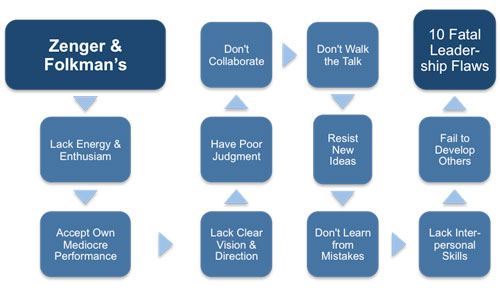Zenger and Folkman's 10 Fatal Leadership Flaws
Leaders have flaws. No matter how qualified an individual is to hold a position, or how prominent that position may be, they are a still a human being just like anyone else. With that said, a smart leader will look at him or herself critically and be able to determine where their flaws may lie. While perfection is likely an unattainable goal, consistent and steady improvement is not. Rather than choosing to ignore any flaws that they may have, the best leader is the one who is able to acknowledge and address their shortcomings.
With this thinking in mind, Zenger and Folkman's 10 Fatal Leadership Flaws take a close look at the most common flaws that plague leaders within even the biggest companies in the world. This study is a relatively young one, only having been published a few years ago. However, it has already garnered plenty of attention and is a valuable reference for anyone in a leadership position. Following is a quick look at each of these 10 fatal flaws.
 |
1) Lack of energy and enthusiasm
A leader should always been the one providing the energy to a project or a team - not the other way around. When the leader lacks the energy and excitement to motive the team that they are in charge of, the project is destined to fail right from the start. Not everyone is going to be a cheerleader, but all leaders should be properly motivated and driven to succeed.
2) Accept their own mediocre performance
Settling for just good enough is never the hallmark of a quality leader. By setting the bar as low as possible and then claiming victory when they step over it, this kind of leader won't be responsible for taking the organization to new heights. In order to find real achievement, it is important the leadership doesn't settle for just so-so.
3) Lack clear vision and direction
A leader isn't really a leader if they don't have a direction and vision of their own - they are simply a follower of a higher ranking leader. In order to take the reins of a project or a team and guide it to a favorable conclusion, a good leader will be able to bring their own vision to the table. This approach to leadership requires confidence and determination because the choices that are made might leave the leader open to criticism in the case of setbacks.
4) Have poor judgment
Making decisions and proper judgments is at the heart of being a good leader. The whole idea behind leadership is having someone available to make the hard choices that need to be made from time to time. A good leader will have a knack for making the right call - while a poor manager will fall short in this area. There is really no way to know how an individual will fare in terms of judgment until they are put into the fire and tested.
5) Don't collaborate
Just because someone is put in a position of leadership doesn't mean they should set out on their own and ignore the input of others. Smart leaders know that collaboration is an opportunity to gain valuable insight from other intelligent people and further the cause of the organization as a whole. Often it is leaders who are insecure in their own abilities who resist the collaborative efforts of others.
6) Don't walk the talk
This is one of the classic mistakes of leadership - not leading by example. When a leader sets out specific guidelines or expectations and then fails to live up to them, it will not look good to the rest of the team. Instead, the leader should be the first one in line to obey all of the conditions that have been put in place to dictate the actions of everyone on the team. Only when they are willing to play by their own rules will they be seen as having integrity.
7) Resist new ideas
Good ideas can come from anywhere, but some leaders are too stubborn or scared to take them if they don't come from inside their own head. Resisting good ideas that come from others is a typical mistake of a bad leader. It shouldn't matter where an idea came from as long as it is genuinely in the best interest of the team - and the organization as a whole.
8) Don't learn from mistakes
Mistakes are always opportunities to do better next time - if a leader is willing to see them as such. A poor leader is more likely to make excuses for their mistakes then they are to learn from them. Those who don't learn from the mistakes they have made are destined to repeat them again and again. The top leaders in any organization are likely the ones who accept their failures and grow so that they don't make the same mistake in the future.
9) Lack interpersonal skills
At its core, leadership is all about interpersonal skills. The way a leader interacts with those who are on the team - as well as others in the organization - will largely determine their success or failure in the long run. The leaders who are well liked and are able to connect with those around them will be far more likely to be viewed favorably. Among leaders with similar performance results, the ones who have the best interpersonal skills will almost always rise to the top.
10) Fail to develop others
The best leaders are more concerned with the growth of those on their team then they are their own development. When a leader is completely committed to make each member of the team the best that they can be, the overall good of the organization is served. Selfish leaders will typically be short for their positions as the performance of the team is going to suffer.
Zenger and Folkman's 10 Fatal Leadership Flaws should be required reading for anyone in a position of leadership. Many leaders are unable to accept their own flaws and acknowledge the fact that they make mistakes - but that is exactly what a great leader is willing to do. If you are in a leadership position, take the time to look inwardly and think about these ten points. When you spot any of them in your own performance, take the necessary steps to correct your leadership style and you will be better for the effort.
You may also be interested in:
Action Centered Leadership | Blake-Mouton Managerial Grid | Dunham and Pierce's Leadership Process Model | Fiedler's Contingency Model | French and Raven's Five Forms of Power | Hersey-Blanchard Situational Leadership Theory | Tannenbaum-Schmidt Leadership Continuum | Lewin's Leadership Styles Framework | Path-Goal Theory | Zenger and Folkman's 10 Fatal Leadership Flaws.



